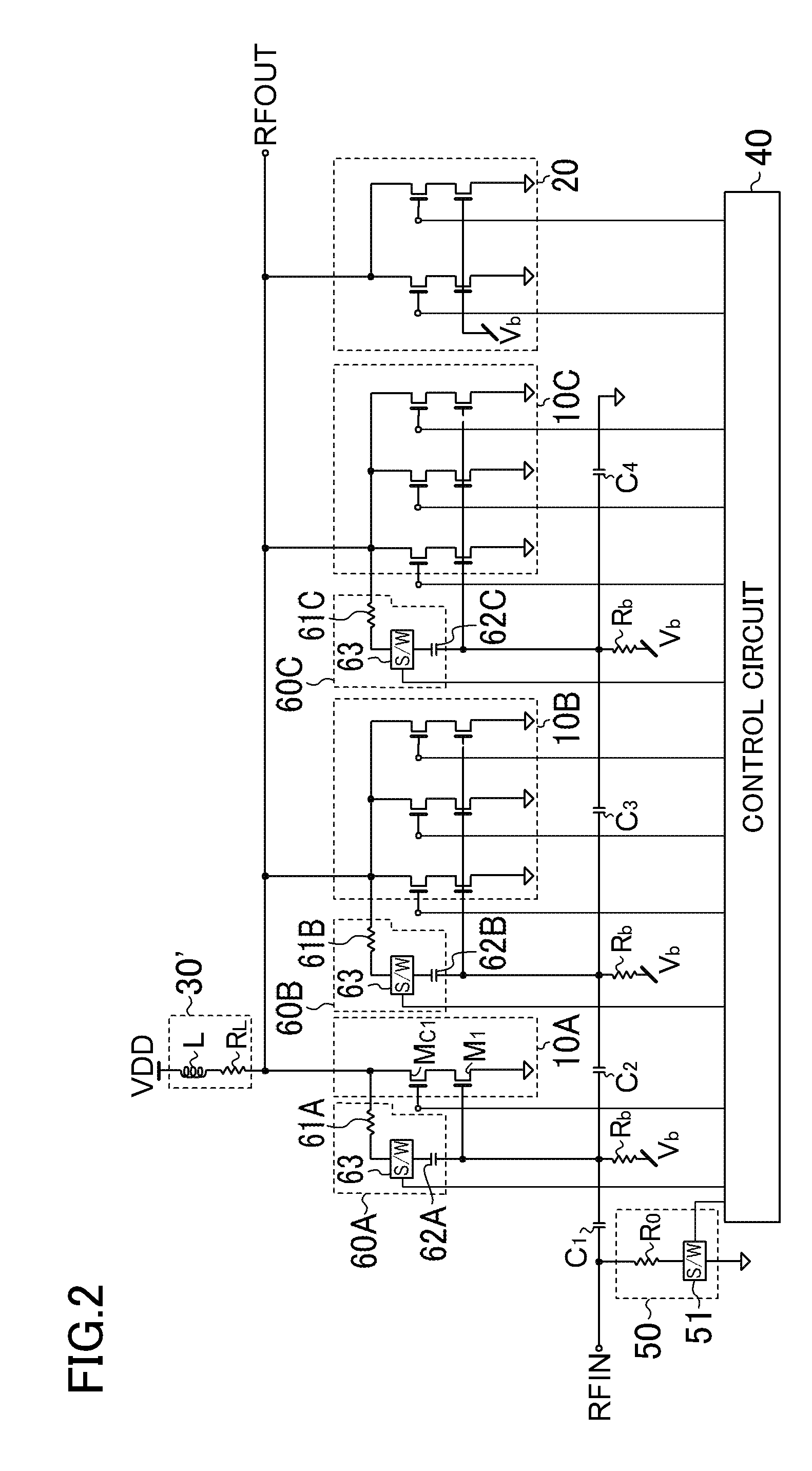Variable gain amplifier and high-frequency signal receiving apparatus comprising the same
a gain amplifier and high-frequency signal technology, applied in the direction of amplifier combinations, gain control, gated amplifiers, etc., can solve the problems of consuming more electric power, degrading linearity at low-voltage operation, and unable to receive lossless signals from antennas
- Summary
- Abstract
- Description
- Claims
- Application Information
AI Technical Summary
Benefits of technology
Problems solved by technology
Method used
Image
Examples
first embodiment
[0023]FIG. 1 is a configuration diagram illustrating a variable gain amplifier according to the first embodiment. A cascode amplification unit 10 includes three cascode amplifiers 11n (n denotes an integer from 1 to 3) connected in parallel. Each cascode amplifier 11n includes an NMOS transistor M1n and an NMOS cascode transistor MC1n. The input end of the cascode amplification unit 10 is connected to the signal input end RFIN of the variable gain amplifier through a DC-cut capacitor C1. A bias voltage Vb is applied to the gate of each transistor M1n through a bias resistor Rb. The size ratio of the transistor M12 to the transistor M13, and the size ratio of the cascode transistor MC12 to the cascode transistor MC13 are each 2:1, where each transistor size is defined by channel width / channel length.
[0024]A cascode current source unit 20 includes two cascode current sources 21m (m denotes an integer from 2 or 3) connected in parallel. Each cascode current source 21m includes an NMOS ...
second embodiment
[0031]Variable gain amplifiers have to receive a signal as losslessly as possible regardless of the intensity of the signal inputted from the antenna. Therefore, the input impedance of a variable gain amplifier preferably has the same value as the characteristic impedance of the antenna (typically, 50Ω or 75Ω for TV receiver).
[0032]FIG. 2 is a configuration diagram illustrating a variable gain amplifier according to a second embodiment. The variable gain amplifier according to the second embodiment is configured so that the variations in input impedance at the time of gain switching are smaller. Hereinafter, a description is given only for the parts different from the corresponding parts in the first embodiment.
[0033]The variable gain amplifier according to the second embodiment includes three cascode amplification units 10A, 10B, and 10C. The cascode amplification units 10B and 10C has the same configuration as the cascode amplification unit 10 illustrated in FIG. 1. The cascode am...
third embodiment
[0050]In a CMOS structure, there is a large parasitic capacitance between a capacitor and the silicon substrate. Therefore, the resistance component of the substrate degrades the S / N characteristics of a high-frequency signal. Specifically, in the case where the DC-cut capacitor C1 illustrated in FIG. 2 is provided within the integrated circuit, the noise factor is degraded during maximum gain operation. Therefore, the DC-cut capacitor C1 is preferably provided outside the integrated circuit.
[0051]FIG. 4 illustrates a configuration of a variable gain amplifier according to a third embodiment. In the variable gain amplifier according to the third embodiment, the configuration elements of the variable gain amplifier illustrated in FIG. 2 except the DC-cut capacitor C1 are provided in an integrated circuit 100, and the DC-cut capacitor C1 is provided outside the integrated circuit 100. The DC-cut capacitor C1 may be provided on a printed board, in a module, or in a package.
[0052]In the...
PUM
 Login to View More
Login to View More Abstract
Description
Claims
Application Information
 Login to View More
Login to View More - R&D
- Intellectual Property
- Life Sciences
- Materials
- Tech Scout
- Unparalleled Data Quality
- Higher Quality Content
- 60% Fewer Hallucinations
Browse by: Latest US Patents, China's latest patents, Technical Efficacy Thesaurus, Application Domain, Technology Topic, Popular Technical Reports.
© 2025 PatSnap. All rights reserved.Legal|Privacy policy|Modern Slavery Act Transparency Statement|Sitemap|About US| Contact US: help@patsnap.com



